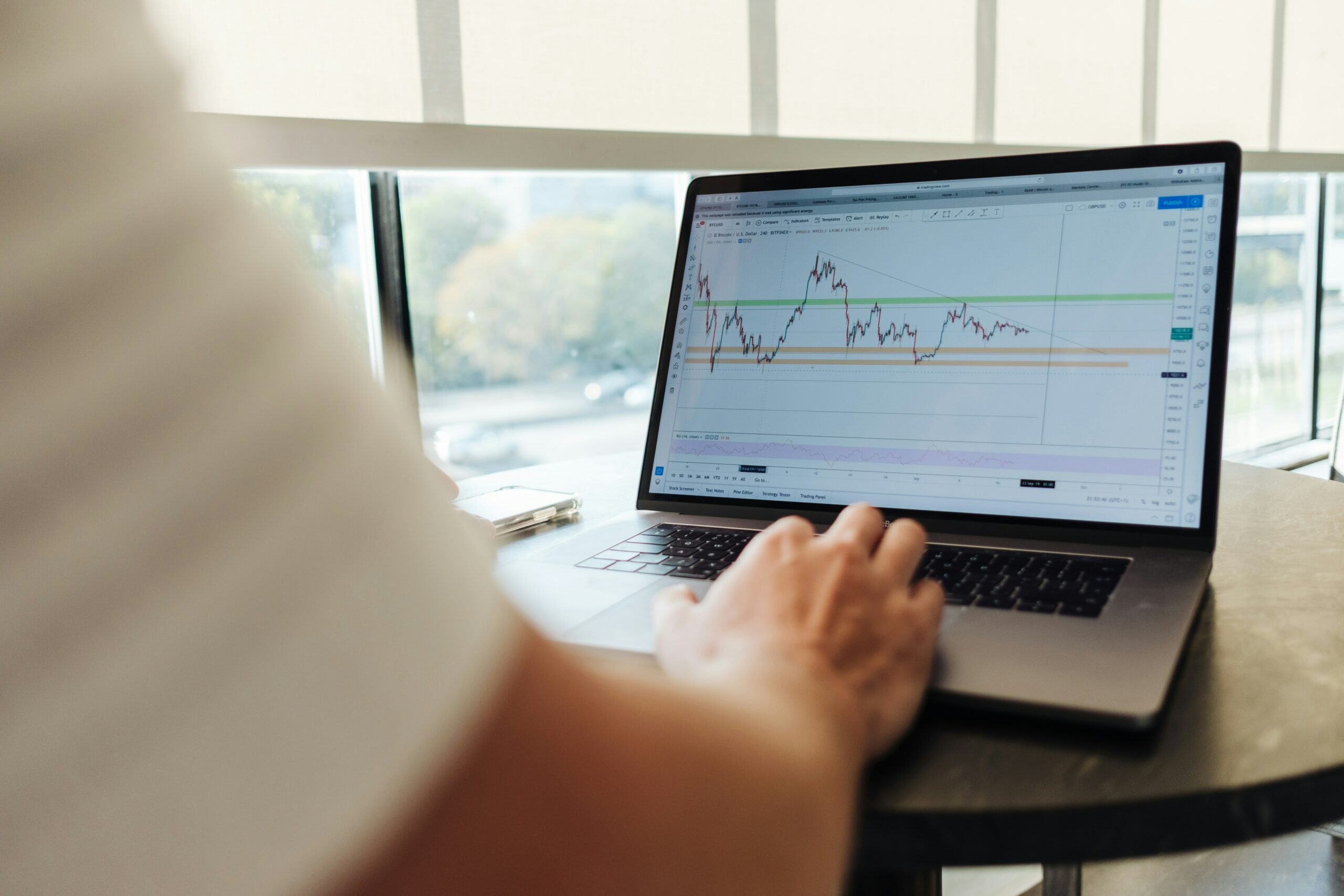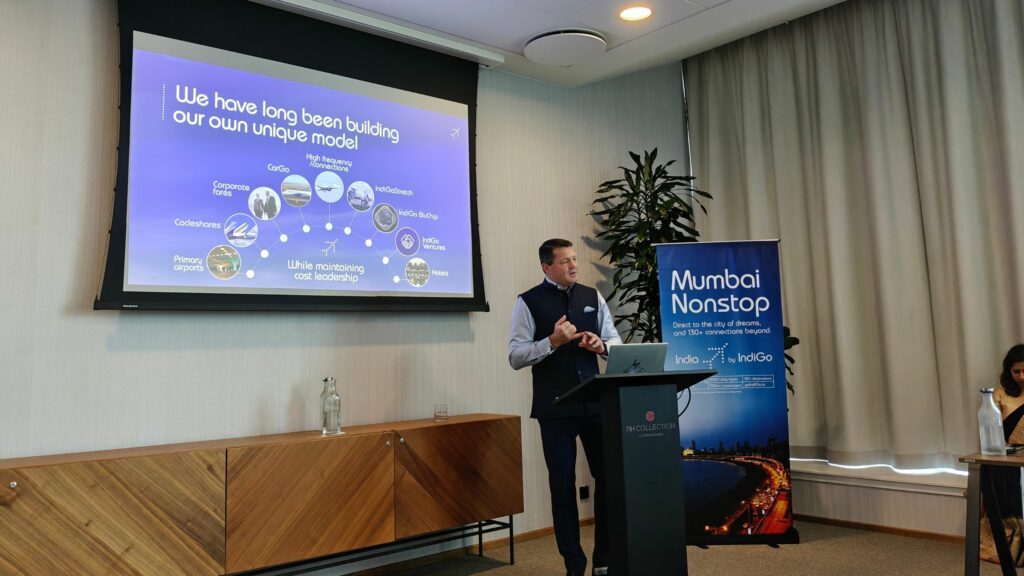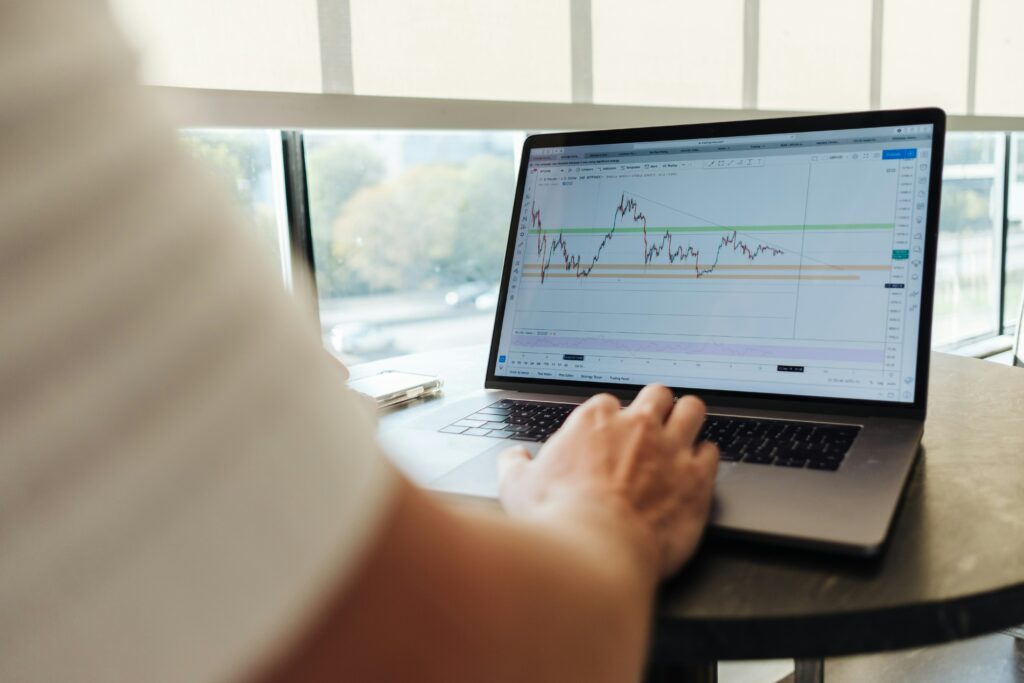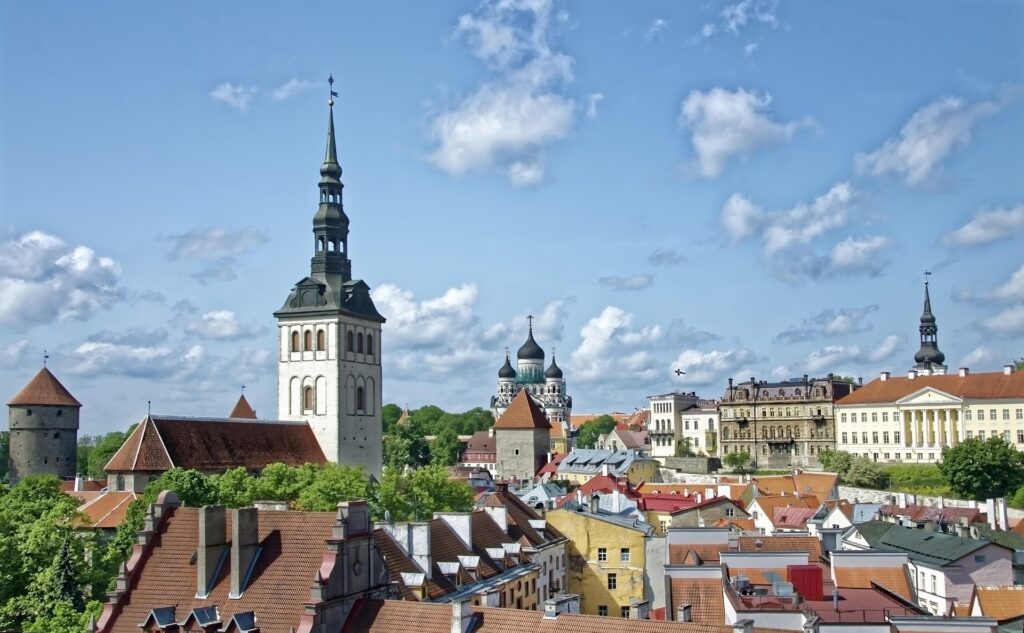The economic outlook for the Nordics and Baltics in 2025 reflects ongoing resilience and adaptability amid global economic challenges. The region’s economy is expected to experience moderate growth, supported by stable government finances, rising real incomes, and lower interest rates.
At the same time, global uncertainties, including trade tensions and geopolitical risks, remain potential obstacles.
Let us take a more detailed look at each country.
Denmark
Denmark’s economy is experiencing growth, however, revisions has been made and combined with a rather sluggish start to 2025, the GDP forecast for 2025 is now less optimistic than previously (Danske Bank, 2025; SEB, 2025). Now, the expected GDP growth for 2025 is 1.8 per cent, down from 1.9 per cent, though this estimate is markedly lower than the Danish National Banks’s more optimistic prediction of 3.6 per cent for the same period (Nationalbanken, 2025). However, it remains unchanged for 2026 at 2.5 per cent, indicating that the foundation of the Danish economy remains really strong. Inflation remains low, and recently, the electricity tax will be eliminated by 2026, which could positively affect private consumption, especially with rising real incomes (Ibid.).
Consumer spending: At the moment, household finances are doing well, with wages increasing and unemployment remaining relatively low. Furthermore, household savings are currently at their highest level since 2020; consequently, there is an opportunity for converting some of these savings into consumption. It remains uncertain, though, because of the geopolitical situation and political turmoil, which may affect the world economy negatively (Danske Bank, 2025; SEB, 2025). Despite this, Danske Bank believe we will see a more significant increase in household consumption this year (Danske Bank, 2025).
Labour market: Unemployment has decreased from 2024 to 2025, from 6.7 per cent to 6.2 per cent, and is expected to decrease even further in the coming years. So employment is rising rapidly at the moment (SEB, 2025). Furthermore, in the past two years, Denmark has seen wage growth, so now purchasing power has recovered, benefiting the overall economy (Danske Bank, 2025).
Sweden
It appears that the Swedish economy has underperformed in 2025, and now the GDP growth forecast has been readjusted from 1.6 per cent to 1.1 per cent in 2025 (Danske Bank, 2025; SEB, 2025). The latest official figures from Konjunkturinstitutet (2025) suggest the slow performance continues, with a lower projection of 0.9 per cent GDP growth for 2025, underscoring the prolonged economic downturn. Inflation is currently increasing more than anticipated, which negatively affects households.
Consumer spending: It is clear that inflation takes its toll on Swedish households, and combined with weaker real wage growth, private consumption growth in 2025 may be limited (Danske Bank, 2025; SEB, 2025). Inflation has been higher than expected, and is likely to be almost 3 per cent in the months to come (Danske Bank, 2025). The government’s expansionary fiscal policy is expected to boost consumer confidence and support growth (Ibid.).
Labour market: As the Swedish economy has underperformed so far, the labour market has been negatively affected. The number of new job openings has decreased, and the unemployment rate is anticipated to increase further this autumn (Danske Bank, 2025). However, according to SEB (2025), the unemployment rate is expected to decrease in 2026 and even further by 2027.
Norway
Norway’s economy is expected to grow in 2025 and 2026. Productivity has increased, and there has been a strong pickup in the first half of 2025. In fact, the GDP growth rate has increased since the last report; now it is expected to be 1.9 per cent in 2025, up from 1.7 per cent previously forecasted (Danske Bank, 2025; SEB, 2025) The official figures from Statistics Norway (SSB) confirm the general positive trend with an expected GDP growth in the Mainland economy, though with a slightly lower prognosis (Statistics Norway, 2025).
Consumer spending: Private consumption has only grown moderately, however, Danske Bank (2025) expects inflation to slow even further, and a continued wage growth might positively affect consumer spending. Furthermore, interest rates are anticipated to decrease, supporting consumer spending as well as housing investment (Danske Bank, 2025; SEB, 2025). All in all, household consumption is set to recover even further, as the interest rates and inflation are set to slow down (SEB, 2025).
Labour market: Although there is a strong demand for labour in Norway, the increase in productivity has led to a moderate rise in unemployment. This means that, despite businesses seeking workers, gains in productivity have allowed the existing workforce to produce more, reducing the immediate need to hire additional staff. As a result, unemployment has increased, even though the underlying demand for labour remains robust (Danske Bank, 2025; SEB, 2025).
Finland
The recovery is slowly picking up in Finland, with the GDP growth being higher in 2025 compared to 2024, and it is expected to increase even further in 2026 to 2.0 per cent, according to Danske Bank (2025). However, the Bank of Finland’s latest official forecast is significantly more subdued, projecting a growth of only 0.5 per cent for 2025 and 1.5 per cent for 2026, underlining the fragile nature of the recovery (Bank of Finland, 2025). It appears that the households are benefiting, which may be due to falling interest rates and continued low inflation (Ibid.).
Consumer spending: The Finnish households see real wage growth at the moment, which potentially may influence consumer spending positively, however, unemployment rates remain relatively high compared to other Nordic countries, and increasing, and this may slow down household consumption. That said, inflation remains low, well below 2 per cent, and interest rates are decreasing (Danske Bank, 2025; SEB, 2025).
Labour market: Currently, the labour market is weaker than anticipated, which is slightly surprising as the recovery of the Finnish economy is picking up. The unemployment rate is approximately 9-9.3 per cent, which is more than anticipated in previous forecasts by both Danske Bank and SEB (Danske Bank, 2025; SEB, 2025). Earlier this year, it was expected to increase to 8.8 per cent. However, it is still likely to decline by 2026.
Lithuania
As mentioned previously in one of our economic outlooks, Lithuania entered 2025 on a positive note. This is very much still the case, as GDP grew by 3.2 per cent in the first half of 2025 (SEB, 2025). That said, the overall GDP growth of 2025 is anticipated to be around 2.7 per cent, before increasing to 3.1 per cent in 2026. Furthermore, the possibility of withdrawing pension funds might further stimulate the economy.
Consumer spending: SEB (2025) expect that 35 per cent of assets will be withdrawn from the pension funds, which is a significant amount, which could potentially benefit household consumption. However, wage growth decelerates, and combined with a new tax reform, it may put a hold on consumption. That said, the tax reform is not as extensive as it could have been. Inflation remains above 3 per cent, and is expected to increase in 2026 due to the expected increase in consumption.
Labour market: The labour market in Lithuania is stable, and a significant deterioration during 2025-2026 is not anticipated (SEB Group, 2025). The unemployment rate has been declining throughout 2024, however, it has begun to increase in 2025 (Statistics Lithuania, 2025). That said, it is expected to decline yet again in 2026 and even more in 2027, even though it remains above the EU average (SEB, 2025).
Latvia
Despite facing renewed global challenges, Latvia’s economic recovery is anticipated to gain momentum in 2025 and 2026. GDP growth is set to increase in 2025 by 1.3 per cent, and even further in 2026, indicating that the economy is on the right track (SEB, 2025). However, the official outlook from the Bank of Latvia (June 2025) is more cautious regarding the pace of recovery, projecting a slightly lower GDP growth of 1.2 per cent for 2025, driven by geopolitical uncertainty and weak investment (Latvijas Banka, 2025). According to the Central Statistical Bureau of Latvia (2025b), the GDP increased by 1.7 per cent in the second quarter of 2025.
Consumer spending: While household consumption is projected to increase in 2025 by 1.3 per cent, and even further in 2026, high price levels are currently hindering households. However, wage growth continues to be strong, indicating that growth in consumer spending may pick up (SEB, 2025). Furthermore, inflation remains high, but is set ease in 2026 and 2027 to 2 per cent, instead of the current 3.8 per cent.
Labour market: SEB anticipates the unemployment rate will decrease to around 6.8 per cent in 2025, and even more in 2026 and 2027, to 6.6 and 6.4 per cent respectively (SEB, 2025). The actual unemployment rate was 6.4 per cent in August, reduced by 0.1 percentage points (Central Statistical Bureau of Latvia, 2025a), which may indicate that the decrease in unemployment has begun.
Estonia
GDP growth is currently set to 1.2 per cent for 2025, meaning that SEB has rolled back their expectation to the Estonian economy. Previous reports argued the GDP growth would be 1.8 per cent this year. GDP growth is still expected to grow further in 2026 at 2.5 per cent, so it is evident that the recovery has begun, even though it might go slower than anticipated. However, the recent official forecast from Eesti Pank (September 2025) emphasises that the economic growth expected in 2026 will primarily be supported by government borrowing and investments, rather than spontaneous private demand (Eesti Pank, 2025). Inflation may negatively impact the recovery, as it remains relatively high at 5.2 per cent (SEB, 2025).
Consumer spending: It is clear that wage growth has slowed, and with inflation being so severe, the household consumption is under pressure. Wage growth is currently above inflation, but since it has slowed, and the inflation is eating the real wage growth, it may put a stop to significant consumer spending (SEB, 2025)
Labour market: Since the last update, things have changed a bit, as the unemployment rate is now anticipated to increase compared to 2024. That said, the labour market should remain relatively stable, with the forecast indicating a decline to 6.7 by 2027. Thus, it will not happen overnight, but more gradually (SEB, 2025).
Concluding remarks
The economic trajectory of the Nordic and Baltic regions reflects a nuanced balance between opportunity and risk. While external pressures persist, the outlook for 2025 suggests a positive platform for incremental growth. Labour markets across the region show notable stability, with low unemployment acting as a buffer against broader economic difficulties. Consumer demand is anticipated to strengthen, with 2026 potentially being more pronounced.
References
Bank of Finland. (2025, June 30). New obstacles to Finland’s economic recovery. https://www.bofbulletin.fi/en/2025/4/new-obstacles-to-finland-s-economic-recovery/
Central Statistical Bureau of Latvia. (2025a). Actual unemployment rate reduced by 0.1 percentage points in August. https://stat.gov.lv/en/statistics-themes/labour-market/unemployment/press-releases/23965-unemployment-august-2025?themeCode=NBBA
Central Statistical Bureau of Latvia. (2025b, August 29). GDP up by 1.7 % in Q2 2025. https://stat.gov.lv/en/statistics-themes/economy/gross-domestic-product-quarterly-data/press-releases/24052-gross-domestic
Danske Bank. (2025). Nordic Outlook: September 2025.
Eesti Pank. (2025). FORECAST. Next year’s economic growth will mainly come from government borrowing . https://www.eestipank.ee/press/prognoos-jargmise-aasta-majanduskasv-tuleb-peamiselt-riigi-laenuraha-toel-23092025
Konjunkturinstitutet. (2025, September 24). Konjunkturåterhämtning i svensk ekonomi. https://www.konj.se/publikationer/konjunkturlaget/2025-09-24-konjunkturaterhamtning-i-svensk-ekonomi/
Latvijas Banka. (2025, July 7). Macroeconomic forecasts | June 2025. https://www.bank.lv/en/news-and-events/news-and-articles/news/17258-macroeconomic-forecasts-june-2025?template=tonga
Nationalbanken. (2025, March 19). Dansk økonomi i balance trods usikre tider. https://www.nationalbanken.dk/da/viden-og-nyheder/presse/arkiv/2025/dansk-oekonomi-i-balance-trods-usikre-tider-19-03-2025
SEB. (2025). Nordic Outlook: August 2025.
SEB. (2025). Nordic Outlook: Tarriffs and uncertainty are slowing down the world.
Statistics Lithuania. (2025). Main Lithuanian indicators. https://osp.stat.gov.lt/pagrindiniai-salies-rodikliai
Statistics Norway. (2025, September 16). Oppgangen i norsk økonomi fortsetter. https://www.ssb.no/nasjonalregnskap-og-konjunkturer/konjunkturer/statistikk/konjunkturtendensene/artikler/oppgangen-i-norsk-okonomi-fortsetter










